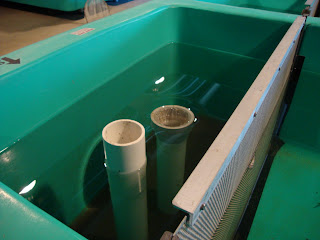This hatchery is located beside the Pearce Estate Park in Calgary. Every year their technician "rears and stocks more than 1,5 million fish" (Bow Habitat's communication) in Alberta. The stocking process is used as a management tool, and it is mainly focus in sportfishing demands. In fact, people really like going for fishing during the summer or the winter in Alberta's lakes. Furthermore, I am volunteer in this educational center, Bow Habitat Station, where it is the hatchery, and they have allowed me to take some photos and create this post.
Esta piscifactoría esta localizada al lado del parque Pearce Estate en Calgary. Segun informacíon recogida de la piscifactoría, cada año sus técnicos crían y distribuyen mas de 1,5 millones de pescado, normalmente en Alberta. La función principal de esta piscifactoría es mantener las poblaciones salvajes de peces suministrando pescado criado en cautividad para la pesca deportiva. Es bien sabido que los habitantes de Alberta disfrután de la pesca, ya sea en verano o invierno. Por otra parte, yo soy voluntaria en este centro educativo, Bow Habitat Station, donde se encuentra la piscifactoría, y me han dado permiso para poder publicar las fotos que tome este verano.
Two stations in Alberta, the Raven and the Allison Creek Brood Trout Station, are going to send the fish eggs to the incubation room of this hatchery. There are 4 stage in the trout life cycle, and this "nursery" room holds the first 2 stages: the egg and the alevin (Bow Habitat's communication).
Dos estaciones en Alberta, la Raven y la Allison Creek, van a enviar los huevos a la sala de incubación de la piscifactoría de Sam Livingston. Las truchas tienen 4 etapas de crecimiento, y las dos primeras se dan en la sala de incubación: huevo y alevin.
 |
| Incubation room for trouts/ Habitación incubadora para truchas |
 |
| Cooler and containers for transport the fish eggs from Trout stations to the Bow Habitat Station/ Nevera y contenedores para transportar los huevos de trucha hasta el Bow Habitat Station. |
 |
| This incubator tray has a capacity for 6,500 eggs/ La bandeja de incubación tiene una capacidad para 6.500 huevos |
 |
| The water temperature is usually 10°C. The cold water makes them grow slower (Bow Habitat's communication)/ La temperatura del agua suele ser 10°C. El agua fría reduce la velocidad de su crecimiento |
 |
| Eyed Eggs Stage (left) and Alevin Stage (right)/ Etapa de Huevos con ojos (izquierda) y Etapa de Alevin (derecha) |
 |
| Rearing Troughs |
 |
| Automatic feeder on the Rearing Troughs/ El dispensador automático de comida en los Rearing Troughs |
 |
| These small fish will eat up to 18 time a day/ Los peces pequeños comen más de 18 veces al día |
 |
| The food for small fish is like powder/ La comida para peces pequeños es como polvo o pequeños gránulos |
 |
| The small fish don't like the light/ A los peces pequeños no les gusta la luz |
 |
| When the fry reach 5 cm, it is moved out to the Super Troughs/ Cuando los peces juveniles tienen un tamaño de 5 cm son movidos a unos tanques mayores, los Super Troughs |
 |
| Automatic feeder |
 |
| Bigger pellets for these fish/ Gránulos mas grandes para estos peces |
After that, it is moved out to the Burrows Ponds/
Cuando los peces juveniles tienen un tamaño de 5 cm son movidos a unos tanques mayores, los Burrows Ponds
 |
| Rainbow trout/ Trucha arcoiris |
 |
| Automatic feeder. The fish will usually eat about 8 times per day/ Alimentador automático. Los peces son alimentados unas 8 veces al día |

Those are the pellets for feeding the fish of the burrows pond/
Este es el pienso para peces mas grandes
When the fish is ready for being stocked, a couple of technicians use a crowder to moved out the fish from the burrows pond to a contained area. Then, the fish are vacuumed up with a fish pump into a holding tank. The hatchtruck will transport the fish into a water body like a lake, etc. (Bow Habitat's communication)/
Cuando los peces tienen las dimensiones apropiadas van a ser recolectados por dos técnico usando una red. Entonces, los peces son aspirados y metidos en un tanque. Un camión transportara los tanques con los peces a un lago, etc.
When the fish is ready for being stocked, a couple of technicians use a crowder to moved out the fish from the burrows pond to a contained area. Then, the fish are vacuumed up with a fish pump into a holding tank. The hatchtruck will transport the fish into a water body like a lake, etc. (Bow Habitat's communication)/
Cuando los peces tienen las dimensiones apropiadas van a ser recolectados por dos técnico usando una red. Entonces, los peces son aspirados y metidos en un tanque. Un camión transportara los tanques con los peces a un lago, etc.
 |
| Hatchtruck with 5 holding tanks/ Camión con 5 tanques llenos de pescado |


















